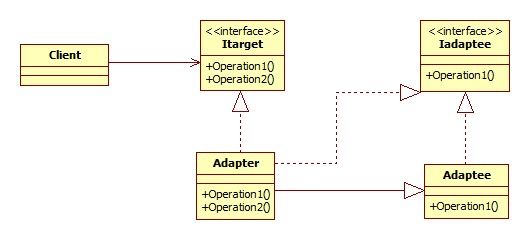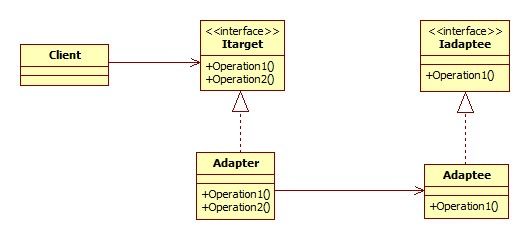设计模式php实例:适配器模式
适配器模式将一个类的换成客户端需要的另一个接口,使原本不兼容的接口能一起工作。一个现实中的例子,假如屋里墙上只有两项插口,而风扇有三个插头,这时需要再拿一个移动插线板,插线板接入墙壁插口的一段是两项插头,插线板另外一段能够提供三项插口给风扇,这时候插线板起到了一个适配器的作用。
在应用中,适配器模式分为类适配器和对象适配器。
类适配器
类适配器中适配器继承原有的Adaptee类,自己实现原类没有的操作。
interface ITarget
{
function operation1();
function operation2();
}
interface IAdaptee
{
function operation1();
}
class Adaptee extends IAdaptee
{
public function operation1()
{
echo "原方法";
}
}
class Adapter extends Adaptee implements IAdaptee, ITarget
{
public function operation2()
{
echo "适配方法";
}
}
class Client
{
public function test()
{
$adapter = new Adapter();
$adapter->operation1();//原方法
$adapter->operation2();//适配方法
}
}
对象配器
类适配器使用的是继承模式,而对象适配器使用的是组合模式,将adaptee作为adapter的一个引用。
interface ITarget
{
function operation1();
function operation2();
}
interface IAdaptee
{
function operation1();
}
class Adaptee extends IAdaptee
{
public function operation1()
{
echo "原方法";
}
}
class Adapter implements ITarget
{
private $adaptee;
public function __construct($adaptee)
{
$this->adaptee = $adaptee;
}
public function operation1()
{
return $this->adaptee->operation1();
}
public function operation2()
{
echo "适配方法";
}
}
class Client
{
public function test()
{
$adapter = new Adapter(new Adaptee(null));
$adapter->operation1();//原方法
$adapter->operation2();//适配方法
}
}由于组合在耦合性上小于继承,对象适配器显得更加灵活,当然它的缺点是增加代码量。 需要重写adapee中的方法的数量太大的话,可以考虑在adapter中使用__call方法委托adapee取得客户端调用的方法
public function __call($func, $args)
{
if (is_callable(array($this->adaptee, $func))) {
return $this->adaptee->$func($args);
}
trigger_error('*********', E_USER_ERROR);
}

